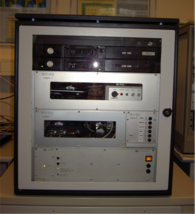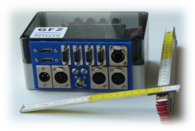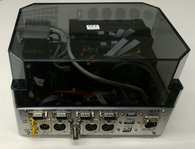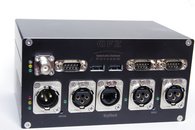Since the foundation of the GFZ, GPS / GNSS observations have been carried out in continuous operation as well as in campaign mode. At the beginning, standard notebooks or PCs were used, but soon the systems became more complex to ensure uninterrupted operation and to enable "self-healing" and remote maintenance. The latest developments are:
GSS (GNSS hardware layout GSS)
Based on a 19 "rack, this station type provides a cold redundancy of all hardware items except the actual sensors (GNSS receiver / weather station). It is a fanless, passively cooled system that has been tested in a climatic chamber at ambient temperatures of -20 to +40 ° C. It has a UPS which provides a power supply of at least 10 hours. The Internet connection is done via a VPN router for secure data transmission and remote management functions. The total current consumption depends on the hardware used and is about 40 to 80 watts. The GSS is the current default layout for use in the global GNSS reference network of the GFZ.
tinyPC (GNSS-Hardware-Layout tinyPC)
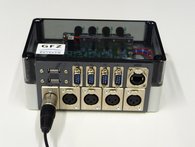
This hardware is based on a low power 3.5" single board computer with a 486 SX processor with 300 MHz (tinyPC). Soon this processor was replaced by a 486 DX processor with 800 MHz (internal designation: tinyPC/2), which allows more computing power with the same power consumption. An internal 4-channel switching unit was developed to monitor the connected devices (like telemetry, GNSS receiver, weather station) and to enable hard resets. So the tinyPC acts as a switchable power supply. The total power consumption is only 2.5 Watt. With an input voltage range of 8 to 18 VDC the tinyPC is ideal for solar power/fuel cell powered applications. There is also a version with an extended input voltage range from 8 to 36 VDC for integration into 24 VDC power supply networks.
All hardware elements are specified for ambient temperatures from -40 °C to +85 °C. This hardware is used for example in the Integrated Plate Boundary Observatory Chile, TERENO (Germany) and ZAIAG (Kyrgyzstan).
As operating system we use a standard Debian Linux distribution. The GNSS station software runs natively on the system.
tinyPC/3 (GNSS hardware layout tinyPC/3)
Developed on the basis of the tinyPC/2, this type includes a JAVAD OEM GNSS board. This board allows the recording of GPS, GLONASS and Galileo signals and is the most compact GNSS measuring system in section 1.1. It is the core of the facilities for campaign operation, but can also be used as a real-time reference station when the power consumption is a critical issue. The overall performance of the tinyPC / 3 type GNSS station is approximately 5 watts. This type is successfully used, e.g. at the Dead Sea and, together with the Alfred Wegener Institute, at Neumayer Station in Antarctica.
tinyPC / 4 (GNSS hardware layout tinyPC / 4)
The newest development of the station hardware is a further development of the tinyPC/3. In addition to an improved GNSS receiver for GPS / Glonass /Galileo / Beidou tracking, this type includes two redundant single-board computers and a GSM / WAN / VPN router for redundant data connection. It is planned to use this type as a future standard for our global network.
tinyBlack (GNSS hardware layout tinyBlack)
The tinyBlack is a robust, inexpensive unit for GNSS raw data recording. It consists of a Linux PC and a L2 GNSS receiver utilizing the civilian signals from GPS, GLONASS, Galileo and BeiDou. The tinyBlack is suitable for the highly precise determination of coordinates (e.g. for monitoring dams or volcanoes), as a reference station (e.g. for drones) in post-processing and for determining the water vapor content of the atmosphere.


